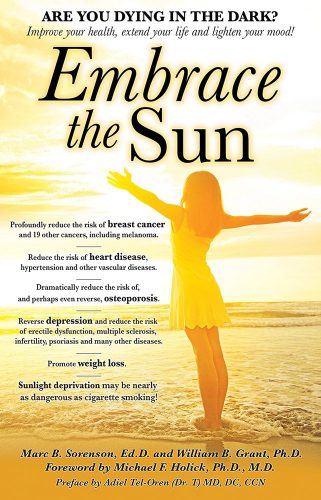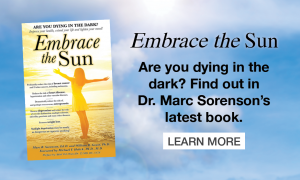Sepsis and septicemia, major killers that associate with sun deprivation. By Marc Sorenson, EdD

Sepsis facts:
Sepsis is an infection of tissues by bacteria, and septicemia is a form of sepsis that infects the blood. Septicemia is a severe and often deadly blood infection. Noxious bacteria attack tissue or blood, and when they die or when their cell walls rupture, they release poison (endotoxin). So, these dying organisms may do more harm than the bacterial attack itself. In addition, the disease accounts for 500,000 emergency-room hospital visits per year in the USA. And, it is followed by a typical stay of 6 to 9 days.[1] As a result, it is one of the worst medical conditions. And, it often results in multiple organ failure and death. There are about 750,000 cases per year, and about 3% of all hospital admissions result in a case of sepsis. Read more.
Sepsis and hospitals
Hospitals are hotbeds of antibiotic-resistant “superbugs” and other infectious agents. In cases of severe sepsis, antibiotics have not improved survival. In fact, antibiotics may produce molecules that exacerbate sepsis.[2] Therefore, the health system must urgently find and implement non-antibiotic solutions to this crisis.
Also, it should be remembered that sunlight is said to be the best disinfectant.[3] The annual cost of care for sepsis is about $17 billion. And, in the case of severe sepsis, antibiotics have not improved survival. In fact, it is especially relevant that antibiotics may produce molecules that exacerbate it.[4] Sepsis is one of the top-ten causes of death and the second leading cause of hospital-associated deaths. So only coronary intensive care units end up having more deaths. In North America, sepsis and its related disorders kill more hospitalized people than heart attacks, colon cancer, breast cancer or AIDS.
Dr. William B. Grant’s research with sepsis and septicemia.
Dr. William Grant hypothesized that vitamin D deficiency, due to inadequate sun exposure, is a risk factor. That is true for both sepsis and septicemia.[5] He points out that septicemia incidence is also highest in winter and lowest in the autumn. Another point is that rates are highest in the Northeast (low sunlight) and lowest in the Southwest (high sunlight).[6] Therefore, all of this leads to the idea that sun deficiency is a major cause this disorder.

Consequently, sun deficiency could play a strong causal role in the disease, since deficiency inhibits the production of cathelicidins. Cathelicidins are antimicrobial peptides which facilitate the destruction of pathogenic germs’ cell walls, leading to their death. In addition, these peptides also help inactivate the endotoxins released as a result of that destruction.[7], [8], [9]
Stay well and thereby avoid hospitals (and sepsis).
Finally, it would be best to avoid hospitals and their superbugs. The formula? Obtain some regular, non-screened, non-burning sunlight around noon when available. Happy sunning! And be sure to read my new book, Embrace the Sun.

[1] http://www.summitmedicalgroup.com/library/adult_care/ac-sepsis_dx/
[2] Mookherjee N, Rehaume LM, Hancock RE. Cathelicidins and functional analogues as antisepsis molecules. Expert Opinions on Therapeutic Targets 2007;11:993-1004
[3]http://sunlightinstitute.org/tag/sepsis/.
[4] Mookherjee N, Rehaume LM, Hancock RE. Cathelicidins and functional analogues as antisepsis molecules. Expert Opinions on Therapeutic Targets 2007;11:993-1004.
[5] Grant, WB. Solar ultraviolet-B irradiance and vitamin D reduce the risk of septicemia. Dermatoendocrinol 2009;1:37-42.
[6] Danai PA, Sinha S, Moss M, Haber MJ, Martin GS. Seasonal variation in the epidemiology of sepsis. Crit Care Med. 2007;35:410–15.
[7] Giacometti A, Cirioni O, Ghiselli R, Mocchegiani F, D’Amato G, Circo R, Orlando F, Skerlavaj B, Silvestri C, Saba V, Zanetti M, Scalise G. Cathelicidin peptide sheep myeloid antimicrobial peptide-29 prevents endotoxin-induced mortality in rat models of septic shock. Am J Respir Crit Care Med 2004;169:187-94.
[8] Giacometti A, Cirioni O, Ghiselli R, Bergnach C, Orlando F, D’Amato G, Mocchegiani F, Silvestri C, Del Prete MS, Skerlavaj B, Saba V, Zanetti M, Scalise G. The antimicrobial peptide BMAP-28 reduces lethality in mouse models of staphylococcal sepsis. Crit Care Med. 2004;32:2485–90.
[9] Cirioni O, Giacometti A, Ghiselli R, Bergnach C, Orlando F, Silvestri C, Mocchegiani F, Licci A, Skerlavaj B, Rocchi M, Saba V, Zanetti M, Scalise G. LL-37 protects rats against lethal sepsis caused by gram-negative bacteria. Antimicrob Agents Chemother. 2006;50:1672–9
Obesity in children: Caused by pregnant mom’s sun deprivation? By Marc Sorenson, EdD. 
Obesity in children is linked closely to maternal vitamin D status in pregnancy.[1] And is anyone surprised about this? First of all, everyone should know that vitamin D deficiency is caused by inadequate sun exposure. So, if high vitamin D is associated with less weight, it is because of high sun exposure. That is of course, unless the research involves vitamin D supplementation. Because sunlight produces nitric oxide, endorphin, serotonin, dopamine and other chemicals, only research can determine if vitamin D is protective. Therefore, a supplementation study would be required.
What did the research show regarding obesity?
It seems like sun exposure, which produces all of the photoproducts, would always be the best way to prevent weight gain. Most noteworthy, however, is that we are discussing only the sun deprivation aspects of obesity. That is because being overweight is primarily due to 1. eating junk food and 2. not staying active. This blog, however, deals only with extra weight due to sun deprivation.
So what did this obesity study show? To perform the research, pregnant women were first of all measured for vitamin D levels before birth. In addition, their newborns were followed for 4-6 years and then compared for obesity levels. In conclusion, those whose mothers had the lowest vitamin D levels had children with the greatest obesity problems.
So, we still don’t know if vitamin D was the protective photoproduct against obesity in children. Because of that lack of surety, let’s visit some research on sunlight and obesity.
In addition to the aforementioned research, another scientific paper “sheds more light” on the subject of obesity.[2]
This research was conducted on mice with shaved backs, because the applied light needed to be unimpeded by hair. Also, a second part of the experiment was to put them on a high-fat diet. Finally, they were exposed to non-burning ultraviolet radiation (UVR) during a three-month period. (UVR is the same light they would receive from sunlight). The mice, because of the high-fat diet, would have been expected to gain weight rapidly. But with UVR, the weight gain was consequently (and impressively) reduced. As a result of the treatment the mice achieved 30-40% less weight gain. That is, compared to the expected weight gain.
Blue light for reduced obesity?
Furthermore, a study published in 2017 showed that the blue-light spectrum of sunlight can cause subcutaneous fat to decrease.[3] In other words, it can cause obesity to diminish, much as good nutrition would also cause it to decrease. Thus, the action of sunlight may help one to prevent obesity or even to create slimness. Consequently, blue light from the sun may be a preventer of obesity, and an adjunct to good nutrition and exercise.
Is obesity reduced by morning light?
So—here we have another benefit of sun exposure—morning sun specifically! A recent study from Northwestern Medicine demonstrates that timing and intensity of light correlate with body mass index (BMI).[4] So to understand the research we need to understand BMI. BMI is a numerical computation comparing height and weight. And it is a commonly used method to assess obesity or the lack thereof. So a high BMI usually means a person is obese or at least approaching obesity. Optimal BMI is 18-25. Below 18 is considered underweight, above 25 is overweight, 30 is obese and 40 and above is morbidly obese.
So does sun exposure influence BMI? Is obesity reduced?
This study showed, first of all, that exposure to bright morning light was directly related to BMI. After adjusting for confounders, it was determined that very early exposure to morning light correlated remarkably to lower BMI. Opposite to what one might expect, when light intensity was equal at different times of the day, results were identical. Consequently, those who received the earliest bright light had lower BMI. Furthermore, for each hour later in the day when light exposure occurred, BMI increased by 1.3 units. This fact is exceptionally important, since a person who has a BMI of 25 (upper ideal range) could approach 30 (obesity). And that would be due to the habit of later sun exposure (10:00 AM rather than 6:00 AM).
Does vitamin D supplementation help prevent obesity?
Another scientific paper “sheds more light” on the subject of obesity.[5] This research was conducted on mice with shaved backs that were placed on a high-fat diet and then exposed to non-burning ultraviolet radiation (UVR) during a three-month experiment. The mice, without the benefit of UVR, would have been expected to gain weight rapidly on that diet, but when they were exposed to UVR, the weight gain was impressively reduced. The UVR treatment achieved a 30-40% reduction in weight gain, compared to the expected weight gain with the high-fat diet.
Interestingly, when vitamin D supplementation was used, it did not help, and actually stopped the positive effects of UVR treatment.
In conclusion, the pandemic of obesity may be exacerbated by sun deprivation. And, it may be due to something other than low vitamin D. Expectant mothers and their children should always obtain plenty of non-burning sun exposure. So should most other members of the human race. Happy sunning! 
Also see: http://sunlightinstitute.org/sun-exposure-reduces-obesity-vitamin-d-not
Read My book, Embrace the Sun, available at
Time limit is exhausted. Please reload CAPTCHA.
[1] V. Daraki T. Roumeliotaki G. Chalkiadaki M. Katrinaki M. Karachaliou V. Leventakou M. Vafeiadi K. Sarri M. Vassilaki S. Papavasiliou M. Kogevinas L. Chatzi. Low maternal vitamin D status in pregnancy increases the risk of childhood obesity
[2] Geldenhuys S, Hart PH, Endersby R, Jacoby P, Feelisch M, Weller RB, Matthews V, Gorman S. Ultraviolet radiation suppresses obesity and symptoms of metabolic syndrome independently of vitamin D in mice fed a high-fat diet. Diabetes. 2014 Nov;63(11):3759-69
[3] Ondrusova K, Fatehi M, Barr A, Czarnecka Z, Long W, K Suzuki K, Campbell S, Philippaert K, Hubert M, Tredget E, Kwan P, Touret N, M Wabitsch M, Lee K, Peter E. Light P. Subcutaneous white adipocytes express a light sensitive signaling pathway mediated via a melanopsin/TRPC channel axis. Scientific Reports 2017 November 27;7:16332
[4] Reid KJ, Santostasi G, Baron KG, Wilson J, Kang J, Zee PC. Timing and intensity of light correlate with body weight in adults. PLoS One 2014;2;9(4)
[5] Geldenhuys S, Hart PH, Endersby R, Jacoby P, Feelisch M, Weller RB, Matthews V, Gorman S. Ultraviolet radiation suppresses obesity and symptoms of metabolic syndrome independently of vitamin D in mice fed a high-fat diet. Diabetes. 2014 Nov;63(11):3759-69
Today I happened to run across research that stunned me while also making me very happy. A study from New Dehli, India has concluded that babies should sunbathe at least 30 minutes weekly.[1] The reason is that most mothers, and their babies are severely vitamin D deficient, and that rickets, which is a vitamin D deficiency disease, is rampant in that country. The authors said that 90% of the vitamin D requirement could be met from sun exposure. That is a strange statement, considering that sun exposure could easily take care of 100% of the vitamin D requirement.
Oher good things to come from this study: the recommendation for the best sunbathing time was between the hours of 10:00 AM and 3:00 PM, exactly the times that most dermatologists say we should avoid like the plague.
A downside of the report was that the scientists recommended on 40% of the body surface to receive sun exposure. Whole-body exposure would have provided a lot more vitamin D and in a much shorter period of time. Another downside was the recommendation to achieve a serum vitamin D level of 20 ng/ml, which is woefully low. They should have recommended at least twice that level.
The report stated that “sunning” the babies would benefit more than 16 million born each year in India.
It is interesting that sometimes it takes a disaster like rickets for the truth to come full-circle and for common sense to prevail. For example, In the 1930s, when the medical community had not yet bought into the sun phobia of today, the Department of Labor printed a pamphlet called Sun for Babies in which they made this statement: “Every mother who wishes her baby to have robust health should give him regular sun baths from early infancy until he is old enough to play in the sun himself. If the sun’s rays are to help the baby grow properly and to prevent rickets, they must fall directly on the skin and tan it.” That would not be popular advice today, and it is likely that any parent practicing “baby tanning” would be arrested for child abuse. Since the 1930’s the dermatological profession has come a long way… in the wrong direction.
Other research related to bone growth in children shows that those who are growth-hormone deficient, and are being treated for that deficiency, grow more rapidly during summer months.[2] In a one-year study using 118 children from 14 countries as subjects, growth was measured and compared to the amount of sun received by the children. Those who were exposed to more sun had faster growth.
The truth will prevail. The advice to keep children out of the sun has been an unmitigated disaster. Just be sure to keep them safe from sunburn.
[1] Research matters. 9/14/17. https://researchmatters.in/shots/infants-should-sunbath-30-minutes-week-recommends-study.
[2] De Leonibus C, Chatelain P, Knight C, Clayton P, Stevens A. Effect of summer daylight exposure and genetic background on growth in growth hormone-deficient children. Pharmacogenomics J. 2015 Oct 27.[Epub ahead of print].
A review published in the journal Nutrients discusses a great deal of research that indicates vitamin D provides protection against internal infection.[1] It regulates both innate (inborn, quick acting, short lived) immunity and acquired (promoted by response to an invasive organism and producing a long-lasting effect) immunity. 
The researchers extoll the virtues of vitamin D in increasing the strength of both forms of immunity, and state that vitamin D deficiency is associated with an increased risk for various infections, including HIV, respiratory tract and HCV infection. However, when discussing the efficacy of vitamin D supplementation, they state that “robust data from controlled trials investigating the use of vitamin D as a preventive or therapeutic agent are missing.”
Unfortunately, the researchers indicate that sun exposure would be a good way to obtain vitamin D in correct amounts, but then destroy that argument by stating that …”UVB radiation is also the main cause of human skin cancer, thus it is difficult, if not impossible, to make a general recommendation to expose the skin to the sun for sufficient vitamin D synthesis.”
They are wrong, of course. Common skin cancers cause very few deaths, and melanoma, the deadly cancer, is far less common in people who are regularly exposed to sunlight, compared to those who avoid the sun. Outdoor workers have about half the risk of contracting melanoma as do indoor workers.[2]
Another problem that the researchers have with sun exposure as a vitamin D source is this: People who live at high latitudes do not produce any vitamin D from sun exposure in the winter, because there is no UVB light at that time of year. My response to this is the following: Use UVB lamps or sunbeds. Such a suggestion would probably cause the authors of this researchers to melt down. I can hear them screaming “melanoma!” already. I would then direct them to a 20-year study from Sweden, which showed that women who used sunbeds during that 20 years had a 23% reduction in all-cause death risk compared to those who avoided sunbeds.[3] And, they were not at increased risk of melanoma. Also, the subjects in the study who avoided sun exposure were twice as likely to die of any cause compared to those who had the highest sun exposure.
At almost any place on earth, we now have either the sunshine or UVB lamps that can give us the vitamin D we need and the other photoproducts that protect us from myriad diseases, including various infections. It is a shame that too many fail to take advantage.
[1] Juliana de Castro Kroner, Andrea Sommer and Mario Fabri. Vitamin D Every Day to Keep the Infection Away? Nutrients 2015, 7, 4170-4188.
[2] Godar D, Landry, R, Lucas, A. Increased UVA exposures and decreased cutaneous Vitamin D3 levels may be responsible for the increasing incidence of melanoma. Med Hypotheses 2009;72(4):434-43.
[3] Pelle G. Lindqvist, Elisabeth Epstein, Mona Landin-Olsson, Christian Ingvar, Kari Nielsen, Magnus Stenbeck & Håkan Olsson. Avoidance of sun exposure is a risk factor for all-cause mortality: results from the Melanoma in Southern Sweden cohort. J Intern Med. 2014 Jul;276(1):77-86.
A major research paper report in the medical journal, Pediatrics, has shown an alarming increase in vitamin D deficiency among children aged 0-17 years of age. https://www.ncbi.nlm.nih.gov/pubmed/28159871 [1] The researchers use the word “exponential,” and indeed it is, increasing from 3.14 deficient children per 100,000 in the year 2000 to 261 per 100,000 in 2014. We can state that as an 83-times increased risk of vitamin D deficiency, or an 8,300% increase. Either way one states it, it is an alarming increase, and will lead to an overwhelming number of bone diseases and other maladies in the future.
Why would such an increase take place?
That is an easy question to answer. Parents are “protecting” their children from sun exposure by keeping them away from direct sunlight—either by neglecting to take them outside (or demanding they stay indoors)—or slathering them with sunscreens, which can reduce the skin’s production of vitamin D by as much as 99%.[2] In the 1930s, when the medical community had not yet bought into today’s sun phobia, the Department of Labor printed a pamphlet called Sun for Babies in which they made this statement: “Every mother who wishes her baby to have robust health should give him regular sun baths from early infancy until he is old enough to play in the sun himself. If the sun’s rays are to help the baby grow properly and to prevent rickets, they must fall directly on the skin and tan it.” That would not be popular advice today, and it is likely any parent practicing “baby tanning” would be arrested for child abuse. Since the 1930’s the dermatological profession has come a long way… in the wrong direction. This is not to say that all dermatologists are sending the wrong messages. In my new book, Embrace the Sun (scheduled for publication shortly), I draw from the research from several “enlightened” dermatologists who have given stern warnings to their colleagues who are spreading their destructive, anti-sun messages. In fact, the person who is writing the foreword is a dermatologist, and one of the top sunlight/vitamin D scientists in the world.
Another chilling result of robbing our children of sunlight is the dramatic increase in myopia. There are several studies proving this point, but I will mention only one here: This research showed the prevalence of myopia among Chinese children living in Singapore was 29.1%, whereas Chinese children living in Sydney, Australia, had a prevalence rate of only 3.3%. The children in Sydney spent about 13.8 hours per week outdoors compared to 3.05 hours in Singapore. In other words, the children who spent most of their lives indoors, had 9.5 times the risk of developing myopia![3] In addition, rickets is now making a comeback. After a century of knowing how to prevent this disastrous children’s disease, it is returning, and cases of rickets are reported as far south as Texas, Georgia and North Carolina.[4] If children are not allowed to play outside, their vitamin D levels will be no better than if they lived at the North Pole.
But what about future risk of melanoma? Melanoma risk has increased by 3000% since 1935 while outdoor activity has decreased by about 90%.[5] The advice to halt the increase in melanoma, which is given by the melanoma foundations of course, is stay out of the sun and use more sunscreen. That is about as counterintuitive as it gets.
Protect your children from excessive sun exposure by using clothing and shade when they have had enough. Also be sure that the kids gradually and safely develop a protective tan. Never burn!
By Marc Sorenson, Ed.D. An advocate for the sun…Fighting vitamin D deficiency.
[1] Basatemur E, Horsfall L, Marston L, Rait G, Sutcliffe A. Trends in the Diagnosis of Vitamin D Deficiency. Pediatrics. 2017 Mar;139(3).
[2] Matsuoka LY, Ide L, Wortsman J, MacLaughlin JA, Holick MF. Sunscreens suppress cutaneous vitamin D3 synthesis. Journal of Clinical Endocrinology & Metabolism 1987; 64:1165-68.
[3] Rose KA, Morgan IG, J, Kifley A, Huynh S, Smith W, Mitchell P. Outdoor activity reduces the prevalence of myopia in children. Ophthalmology 2008 Aug;115(8):1279-85.
[4]Weisberg P, Scanlon KS, Li R, Cogswell ME. Nutritional rickets among children in the United States: review of cases reported between 1986 and 2003. Am J Clin Nutr 2004;80(6 Suppl):1697S-705S.
[5] Melanoma International Foundation, 2007 Facts about melanoma. Sources: National Cancer Institute 2007 SEER Database, American Cancer Society’s 2007 Facts and Figures, The Skin Cancer Foundation, The American Academy of Dermatology.
By Marc Sorenson, EdD. Sunlight institute. Embracing the sun.
Heart disease is our number-one killer. It is caused primarily by consumption of animal products and lack vegetables, fruits, whole grains, and legumes. However, sun exposure and vitamin D may also have profound effects on the disease.
Italian research shows that vitamin D deficiency is closely associated with heart attacks.[1] The researchers measured vitamin D levels in 478 heart attack patients and discovered an average level of 14.5 ng/ml, which is very deficient. Obviously, there had not been enough sunbathing among this group, and the researchers noted that the risk of heart attack was lower during summer season. Nevertheless, vitamin D levels were still far too low.
The study recommended that “exposure to sunlight may be a cost-saving therapeutic strategy for the management of vitamin D deficiency.”
It is wonderful to see such advice from medical or nutritional experts. However, I opine that low vitamin D may not be the primary photoproduct of sun exposure that exerts a protective influence against heart attacks. Nitric oxide, also produced by sun exposure of the skin, has the ability to impressively lower blood pressure. High blood pressure (hypertension) is a major risk factor for heart disease and heart attacks. See one of my previous posts on blood pressure at http://sunlightinstitute.org/high-blood-pressure-hypertension-caused-low-vitamin-d-levels-sun-deprivation/.
For someone who wishes to stop heart disease in its tracks, don’t eat the food that causes the disease. In addition get a few minutes of midday sun without sunscreen as often as possible. It could help to save your life! Remember not to burn. At the first sign of redness, seek shade or cover up.
[1] Aleksova A, Belfiore R, Carriere C, Kassem S, La Carrubba S, Barbati G, Sinagra G. Vitamin D Deficiency in Patients with Acute Myocardial Infarction: An Italian Single-Center Study. Int J Vitam Nutr Res. 2015;85(1-2):23-30.
By Marc Sorenson, EdD. Sunlight Institute….
COPD is defined as a heterogeneous collection of conditions that can affect various structures within the lung in a number of ways,[1] and usually cause difficulty in breathing. In 2005 there were 126,005 deaths in the US from COPD.[2] Though there are multiple contributors to COPD such as tobacco smoke, occupational dusts, chemicals and air pollution, vitamin D and sun deficiencies may also play a role. Research has demonstrated that the severity of the disease is correlated directly to serum levels of vitamin D,[3] and other research demonstrates that severe disturbed lung and peripheral muscle functions are more pronounced in COPD patients with vitamin D deficiency.[4] In addition, recent research shows that cardiopulmonary exercise capacity is increased remarkably in people with high vitamin D levels compared to those with low levels.[5] Of course, 90% of vitamin D blood levels are produced by sun exposure.
In other blogs, I have established that sun can prevent and even reverse osteoporosis, and it is also well-established that osteoporosis associates closely with COPD.[6] There is a high prevalence of COPD in patients with osteoporosis, and the disease is also more severe in patients with osteoporosis compared with patients with normal bone mass. [7] One may intelligently conclude, based on this information, that a part of the cause for both diseases is a lack of sun-derived vitamin D (and perhaps other sun-stimulated photoproducts). It is surprising that little or no research has been done on the effects of sun exposure per se. I would think that in very sunny areas, the risk of the disease would be reduced profoundly.
Now doesn’t that make you breathe easier?
[1] Rennard, S. COPD: Overview of Definitions, Epidemiology, and Factors Influencing Its Development. Chest 1998;113(4)(Suppl 4):235s-241s.
[2] Deaths from Chronic Obstructive Pulmonary Disease—United States, 2000-2005. JAMA 2009; 301(13):1331-1333.
[3] Janssens W, Bouillon R, Claes B, Carremans C, Lehouck A, Buysschaert I, Coolen J, Mathieu C, Decramer M, Lambrechts D. Vitamin D deficiency is highly prevalent in COPD and correlates with variants in the vitamin D-binding gene. Thorax 2010;65(3):215-20.
[4] Yumrutepe T, Aytemur ZA, Baysal O, Taskapan H, Taskapan CM, Hacievliyagil SS. Relationship between vitamin D and lung function, physical performance and balance on patients with stage I-III chronic obstructive pulmonary disease. Rev Assoc Med Bras. 2015 Mar-Apr;61(2):132-8.
[5] Kaul A, Gläser S, Hannemann A, Schäper C, Nauck M, Felix SB, Bollmann T, Ewert R, Friedrich N. Vitamin D is associated with cardiopulmonary exercise capacity: results of two independent cohorts of healthy adults. Br J Nutr. 2016 Feb 14;115(3):500-8
[6] Romme EA, Smeenk FW, Rutten EP, Wouters EF. Osteoporosis in chronic obstructive pulmonary disease. Expert Rev Respir Med. 2013 Aug;7(4):397-410.
[7] Silva DR, Coelho AC, Dumke A, Valentini JD, de Nunes JN, Stefani CL, da Silva Mendes LF, Knorst MM. Osteoporosis prevalence and associated factors in patients with COPD: a cross-sectional study. Respir Care. 2011 Jul;56(7):961-8.
By Marc Sorenson, EdD Sunlight Institute…
Research from Singapore, a very sunny country, demonstrated that 57% of older adults with hip fractures were vitamin D deficient.[1] The researchers note that in Western countries with seasonal winters, D deficiency is common due to the reduction in sunlight. But on measuring serum vitamin D in fracture patients in sunny Singapore, they found that 57.5% were suffering deficiency and 34.5% were suffering insufficiency. Only 8% of the patients had normal vitamin D levels.
One might ask why people residing in a sunny, predominantly tropical climate would have such a high degree of vitamin D deficiency and consequently high fracture risk. Further study found the answer: Most of the people who suffered fractures had been housebound and had little sun exposure. The authors of the paper made the following statement: “Another factor was Malay ethnicity (dark skin, which inhibits vitamin D production), and clothing habits that prevented sun exposure.”
The authors of the paper concluded with this statement: “Vitamin D deficiency and insufficiency are common in patients with hip fracture in Singapore. Vitamin D deficiency was associated with being housebound and those of Malay ethnicity. Clothing habits resulting in reduced sunlight exposure may increase the risk of vitamin D deficiency.”
The same pattern of high D deficiency also exists among youth in some sunny countries; in Qatar deficiency is common. [2] Sixty-eight percent of the children there are deficient and the girls are especially likely to be deficient. Low duration of time spent outdoors is a major predictor of deficiency, and the children who are deficient suffer a greater incidence of rickets, fractures, and gastroenteritis.
And finally, I would like to remind the readers of research from Spain that I have cited on various occasions. Women who spend their time indoors are about 11 times more likely to have a fracture as those who regularly seek the sun.[3]
A major message is this: If the sunlight is all around you and you don’t expose yourself to it, it will do you no good. You may a well live in the Arctic Circle.
Carefully embrace the sun and save your bones.
[1] Ramason R, Selvaganapathi N, Ismail NH, Wong WC, Rajamoney GN, Chong MS. Prevalence of vitamin D deficiency in patients with hip fracture seen in an orthogeriatric service in sunny Singapore. Geriatr Orthop Surg Rehabil. 2014 Jun;5(2):82-6
[2] Bener A, Al-Ali M, Hoffmann GF. High prevalence of vitamin D deficiency in young children in a highly sunny humid country: a global health problem. Minerva Pediatr. 2009 Feb;61(1):15-22.
[3] Larrosa M, Casado E, Gómez A, Moreno M, Berlanga E, Ramón J, Gratacós J. Vitamin D deficiency and related factors in patients with osteoporotic hip fracture. Med Clin (BARC) 2008;130:6-9.
By Marc Sorenson, EdD
A new article on November 30, 2015, from the Daily Mail, discusses breaking research on the association between ED and vitamin D.[1] The research from Johns Hopkins University, by Dr. Erin Michos and her colleagues, was conducted on 3,400 men over age 20, 30% of whom were vitamin D deficient, and 16% of whom reported symptoms of ED. Men with Vitamin D deficiency were 32% more likely to suffer ED than those whose levels were sufficient.
Although I, along with Dr. Grant, were the first to hypothesize that vitamin D deficiency could lead to ED,[2] I have moderated my opinion somewhat. It is entirely possible that higher vitamin D levels are really a surrogate measurement for sunlight exposure. Although vitamin D probably has a positive affect on ED, the UVA portion of sunlight has a nearly immediate effect in dilating the blood vessels[3] through the production of nitric oxide (NO), which is absolutely necessary for producing an erection.[4] Viagra and other ED drugs work by inhibiting the breakdown of NO, which keeps NO in circulation for a longer period.[5] But, they don’t always work and can have many deleterious side effects.[6]
My hope is that research will be done to determine the effectiveness of sunlight exposure in alleviating the condition. Of course, the underlying cause of ED is consuming foods that occlude the arteries. Sunlight and/or vitamin D serve as palliatives to that occlusion, as do the ED drugs. A nutrition program filled with colorful fruits and vegetables,[i] along with ample sunlight exposure, would, in my opinion, produce the very best results in mitigating or perhaps reversing the disease.
[i] Esposito K, Giugliano F, Maiorino MI, Giugliano D. Dietary factors, Mediterranean diet and erectile dysfunction. J Sex Med. 2010 Jul;7(7):2338-45.
To read the Daily Mail article, please click this link. http://www.dailymail.co.uk/health/article-3321000/Could-daily-dose-vitamin-D-cure-erectile-dysfunction-Deficiency-means-man-32-likely-impotent.html
[1] http://www.dailymail.co.uk/health/article-3321000/Could-daily-dose-vitamin-D-cure-erectile-dysfunction-Deficiency-means-man-32-likely-impotent.html
[2] Sorenson M, Grant WB. Does vitamin D deficiency contribute to erectile dysfunction? Dermato-Endocrinology 4;2:128–136.
[3] Opländer C, Volkmar CM, Paunel-Görgülü A, van Faassen EE, et al. Whole body UVA irradiation lowers systemic blood pressure by release of nitric oxide from intracutaneous photolabile nitric oxide derivates. Circ Res. 2009;105:1031–40.
[4] Burnett AL. The role of nitric oxide in erectile dysfunction: implications for medical therapy. J Clin Hypertens (Greenwich). 2006 Dec;8(12 Suppl 4):53-62
[5] Nitric Oxide and Viagra (no authors listed) Concepts in Biochemistry (accessed on November 30, 2015) at http://www.wiley.com/college/boyer/0470003790/cutting_edge/viagra/viagra.htm.
[6] http://www.healthline.com/health-slideshow/erectile-dysfunction-medications-common-side-effects?stickyLb=true
By Marc Sorenson, EdD, Sunlight Institute
In a new media release from Toronto, the Vitamin D Society asserts that “The importance of natural sunlight to human life cannot be understated.” It goes on to quote Dr. Reinhold Vieth, a scientist and professor at the University of Toronto. “There really is no substitute for natural sunlight in human health. Your skin is like a solar receptor and has the amazing capacity to manufacture all of the vitamin D your body needs. Everyone has the capability to generate vitamin D.”
There is a problem, however, as I posted recently. About a third of Canadians, about 12 million people, do not meet the minimum Health Canada guidelines for vitamin D levels. The reason? Sunlight deficiency.
Perry Holman, executive director of the Society, states that “This is not a call for people to ignore the warnings about over-exposure to sunlight but a call for people to exercise common sense and ensure they are not shutting themselves out from the vital health benefits of natural sunlight.”
Of course, in the winter, when no vitamin D production is available, it will be necessary to find another source of vitamin-D stimulating light. Sunlamps are ideal, provided they produce UVB light.
Also remember, that during winter, sunlight still raises serotonin levels and produces nitric oxide, both of which are necessary to human health. The value of sunlight goes far beyond its ability to promote vitamin D production in the skin.
For more information on the Vitamin D Society, visit www.vitamindsociety.org.




